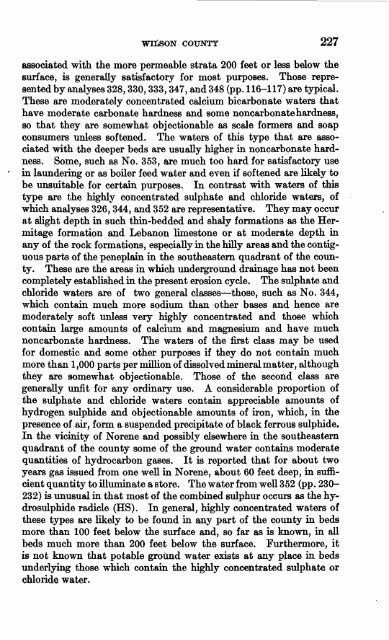GROUND WATER IN NORTH-CENTRAL TENNESSEE
GROUND WATER IN NORTH-CENTRAL TENNESSEE
GROUND WATER IN NORTH-CENTRAL TENNESSEE
Create successful ePaper yourself
Turn your PDF publications into a flip-book with our unique Google optimized e-Paper software.
WIIJSON COUNTY 227<br />
associated with the more permeable strata 200 feet or less below the<br />
surface, is generally satisfactory for most purposes. Those repre<br />
sented by analyses 328,330,333,347, and 348 (pp. 116-117) are typical.<br />
These are moderately concentrated calcium bicarbonate waters that<br />
have moderate carbonate hardness and some noncarbonate hardness,<br />
so that they are somewhat objectionable as scale formers and soap<br />
consumers unless softened. The waters of this type that are asso<br />
ciated with the deeper beds are usually higher in noncarbonate hard<br />
ness. Some, such as No. 353, are much too hard for satisfactory use<br />
in laundering or as boiler feed water and even if softened are likely to<br />
be unsuitable for certain purposes. In contrast with waters of this<br />
type are the highly concentrated sulphate and chloride waters, of<br />
which analyses 326,344, and 352 are representative. They may occur<br />
at slight depth in such thin-bedded and shaly formations as the Her<br />
mitage formation and Lebanon limestone or at moderate depth in<br />
any of the rock formations, especially in the hilly areas and the contig<br />
uous parts of the peneplain in the southeastern quadrant of the coun<br />
ty. These are the areas in which underground drainage has not been<br />
completely established in the present erosion cycle. The sulphate and<br />
chloride waters are of two general classes those, such as No. 344,<br />
which contain much more sodium than other bases and hence are<br />
moderately soft unless very highly concentrated and those which<br />
contain large amounts of calcium and magnesium and have much<br />
noncarbonate hardness. The waters of the first class may be used<br />
for domestic and some other purposes if they do not contain much<br />
more than 1,000 parts per million of dissolved mineral matter, although<br />
they are somewhat objectionable. Those of the second class are<br />
generally unfit for any ordinary use. A considerable proportion of<br />
the sulphate and chloride waters contain appreciable amounts of<br />
hydrogen sulphide and objectionable amounts of iron, which, in the<br />
presence of air, form a suspended precipitate of black ferrous sulphide.<br />
In the vicinity of Norene and possibly elsewhere in the southeastern<br />
quadrant of the county some of the ground water contains moderate<br />
quantities of hydrocarbon gases. It is reported that for about two<br />
years gas issued from one well in Norene, about 60 feet deep, in suffi<br />
cient quantity to illuminate a store. The water from well 352 (pp. 230-<br />
232) is unusual in that most of the combined sulphur occurs as the hy-<br />
drosulphide radicle (HS). In general, highly concentrated waters of<br />
these types are likely to be found in any part of the county in beds<br />
more than 100 feet below the surface and, so far as is known, in all<br />
beds much more than 200 feet below the surface. Furthermore, it<br />
is not known that potable ground water exists at any place in beds<br />
underlying those which contain the highly concentrated sulphate or<br />
chlorid.6 water.

















